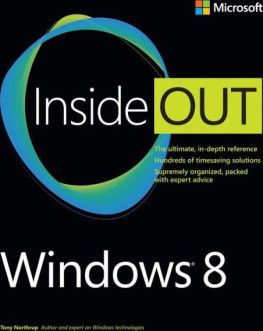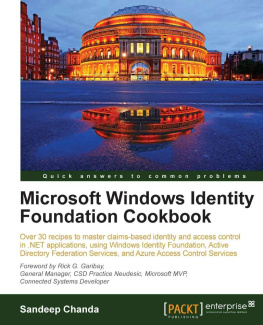Justin Smith - Inside Windows Communication Foundation
Here you can read online Justin Smith - Inside Windows Communication Foundation full text of the book (entire story) in english for free. Download pdf and epub, get meaning, cover and reviews about this ebook. year: 2007, publisher: Microsoft Press, genre: Computer. Description of the work, (preface) as well as reviews are available. Best literature library LitArk.com created for fans of good reading and offers a wide selection of genres:
Romance novel
Science fiction
Adventure
Detective
Science
History
Home and family
Prose
Art
Politics
Computer
Non-fiction
Religion
Business
Children
Humor
Choose a favorite category and find really read worthwhile books. Enjoy immersion in the world of imagination, feel the emotions of the characters or learn something new for yourself, make an fascinating discovery.

- Book:Inside Windows Communication Foundation
- Author:
- Publisher:Microsoft Press
- Genre:
- Year:2007
- Rating:5 / 5
- Favourites:Add to favourites
- Your mark:
- 100
- 1
- 2
- 3
- 4
- 5
Inside Windows Communication Foundation: summary, description and annotation
We offer to read an annotation, description, summary or preface (depends on what the author of the book "Inside Windows Communication Foundation" wrote himself). If you haven't found the necessary information about the book — write in the comments, we will try to find it.
Justin Smith: author's other books
Who wrote Inside Windows Communication Foundation? Find out the surname, the name of the author of the book and a list of all author's works by series.
Inside Windows Communication Foundation — read online for free the complete book (whole text) full work
Below is the text of the book, divided by pages. System saving the place of the last page read, allows you to conveniently read the book "Inside Windows Communication Foundation" online for free, without having to search again every time where you left off. Put a bookmark, and you can go to the page where you finished reading at any time.
Font size:
Interval:
Bookmark:
Dive deep into the operations of Windows Communication Foundation with this practical book. Learn intricacies of Windows Communication Foundation and service-oriented concepts and implementations. Includes Microsoft Visual C#\xae code samples.
"/>Copyright 2010 Justin Smith (All)
Microsoft Press books are available through booksellers and distributors worldwide. For further information about international editions, contact your local Microsoft Corporation office or contact Microsoft Press International directly at fax (425) 936-7329. Visit our Web site at .]
Microsoft, Microsoft Press, Active Directory, BizTalk, Groove, SQL Server, Virtual Earth, Visual C#, Windows, Windows Live, Windows NT, Windows Server, Windows Server System and Windows Vista are either registered trademarks or trademarks of Microsoft Corporation in the United States and/or other countries. Other product and company names mentioned herein may be the trademarks of their respective owners.
The example companies, organizations, products, domain names, e-mail addresses, logos, people, places, and events depicted herein are fictitious. No association with any real company, organization, product, domain name, e-mail address, logo, person, place, or event is intended or should be inferred.
This book expresses the author's views and opinions. The information contained in this book is provided without any express, statutory, or implied warranties. Neither the authors, Microsoft Corporation, nor its resellers, or distributors will be held liable for any damages caused or alleged to be caused either directly or indirectly by this book.
To my parents, Mike and Nancy Smith
for more information on this offer!
Dozens of people helped me write this book. Their dedication of time and energy has helped ensure that this book is well organized and factually correct. They deserve credit for everything that is correct, and none of the blame for any of the mistakes. Blame rests with me.
Although many have helped with this book, Jeffrey Richter has gone above and beyond. His input has helped me become a better developer, presenter, and author. His reputation in the Microsoft Windows development community is well deserved. I will never be able to repay him for his investment in me.
My Review Crew diligently reviewed my chapters and were very open with feedback. This book is much better as a direct result of their input: Arun Chandrasekhar, Doug Holland, George Ivanov, Guy Burstein, Jalil Vaidya, Jason Davis, David Jensen, Krishnan R., Marcelo Lopez, Martin Kulov, Mitch Harpur, Paul Ballard, Rick Casey, and Rob Hindman.
My long-suffering editors also deserve special mention: Kathleen Atkins, Scott Seely, Jennifer Harris, and Ben Ryan. Your patience has been epic.
One of the benefits of working for Wintellect is the high caliber of the staff. Though they may not have helped with the book directly, many Wintellectuals have helped me both professionally and personally: Jeff Prosise, John Robbins, Paula Daniels, Cara Allison, Brendon Schwartz, Sara Faatz, Jim Bail, Sam Easterby, Lewis Frazer, and Todd Fine.
Services are a major part of modern software architecture, and Microsoft Windows Communication Foundation (WCF) is the platform for building services for Microsoft Windows. Services written in WCF are able to interoperate with services from other vendors (for example, IBM, BEA, and Novell), and WCF is extensible enough to keep pace with the inevitable evolution of industry standards. Regarding transports, WCF supports TCP/IP, HTTP, Microsoft Message Queuing (MSMQ), and named pipes. WCF also supports a full array of WS-* (pronounced "WS-star") protocols like WS-Addressing, WS-ReliableMessaging (WS-RM), WS-AtomicTransaction (WS-AT), WS-Security, WS-SecureConversation, WS-Trust, and WS-Federation. Applications that use WCF can send and receive SOAP messages and Plain Old XML (POX) messages. In the future, Microsoft will undoubtedly broaden the capabilities of WCF to include new transports, protocols, and message structures. Microsoft views WCF as the I/O system for services. Although the future is never certain, it is safe to say that Microsoft is not going to replace WCF with another product in the foreseeable future. Consider as evidence the fact that many products like Microsoft BizTalk Server and Microsoft Windows Live Server are fully embracing WCF.
The goal of this book is to equip the reader with the information necessary to design, develop, and maintain services using WCF. In my opinion, these tasks require more than just having a working knowledge of the WCF programming model. Success with WCF requires an understanding of the principles behind services, the WCF programming model, and the WCF infrastructure.
This sort of coupling is not a new idea; it comes from past experience. When object orientation was gaining popularity, developers and architects making the transition from procedural programming to an object-oriented language needed to know more than just the new syntax of the language. If procedural programmers began using a more modern language without understanding how to design objects, they simply created procedural applications in the new language. Although these applications could be compiled and run, they did not take advantage of the functionality offered through object orientation. It is my view that the same will be true of developers who start to use WCF without a clear picture of how to leverage the power of service-oriented application designs.
Some think that this approach is a waste of time. In their opinion, the WCF team has successfully abstracted the messaging infrastructure away from the normal programming model, and as such, there is no need to address the underlying service-oriented paradigms or how the WCF infrastructure implements these paradigms. I completely disagree with this viewpoint. The level of abstraction attained by the WCF team allows applications to be developed more quickly. It does not, however, completely release the developer or architect from the responsibility of making the shift to service orientation or understanding how a WCF application works internally. In much the same way that successful adoption of an object-oriented language like C++ or Java required developers to shift their thinking from procedural programming to object orientation, successful adoption of WCF requires developers to evolve from a component-oriented mindset to a service-oriented mindset. If we fail to make this shift, we run the risk of missing out on many of the features offered through service orientation. Simply writing a WCF application and getting it to compile and run is only part of the battle. Understanding what's inside as well as understanding the new programming paradigm are equally (if not more) important in the long run.
Even if we do not care about the features offered by service-oriented architectures, we should understand the WCF infrastructure. In other words, we should know our platform. The common language runtime (CLR) offers supporting evidence for this stance. The CLR team did a great job abstracting the garbage collector and the JIT compiler away from the developer. As a result, it is technically possible for us to write Microsoft .NET Framework applications with little or no knowledge of how these subsystems work. Failing to understand these concepts, however, increases the risk that we will write inefficient applications. For example, a C++ developer moving to C# without any knowledge of the garbage collector will instinctively add a finalizer to all type declarations. Unknowingly, this developer will have increased the time required to allocate these objects and increased the lifetime of these objects. For most C++ developers, simply saying "don't do it" isn't enough. They want to know why. Technically, adding a finalizer to a type is not a bug, but it is certainly an inefficiency that could have been averted through a couple of hours spent with a book or in a good training course.
Font size:
Interval:
Bookmark:
Similar books «Inside Windows Communication Foundation»
Look at similar books to Inside Windows Communication Foundation. We have selected literature similar in name and meaning in the hope of providing readers with more options to find new, interesting, not yet read works.
Discussion, reviews of the book Inside Windows Communication Foundation and just readers' own opinions. Leave your comments, write what you think about the work, its meaning or the main characters. Specify what exactly you liked and what you didn't like, and why you think so.










